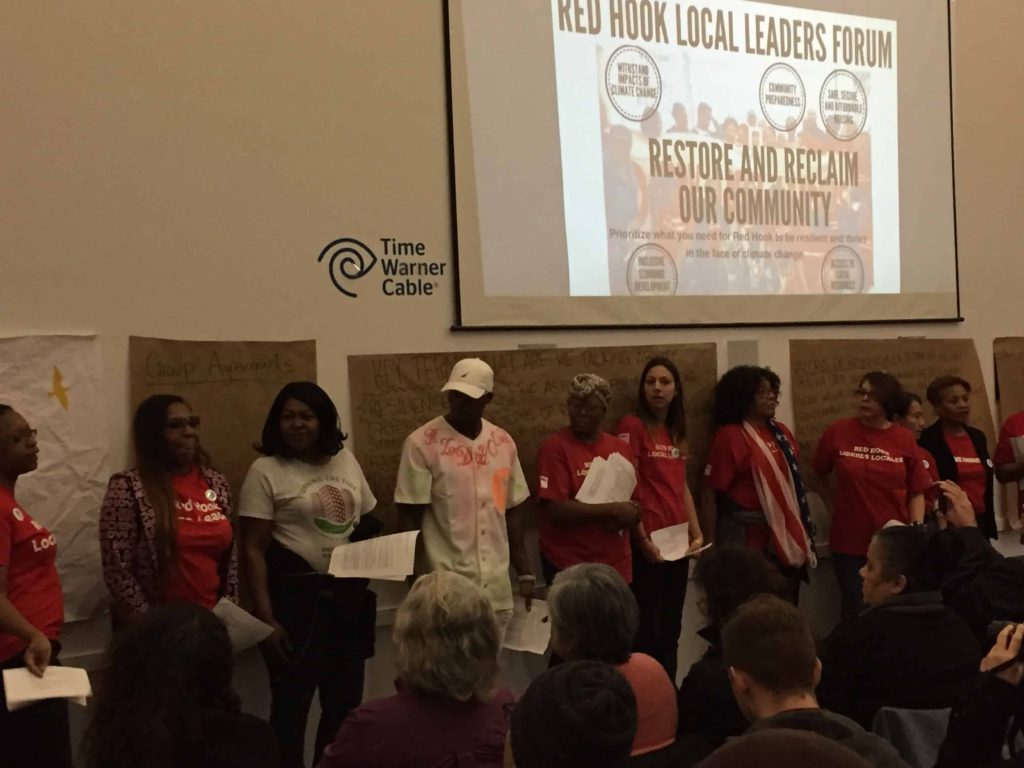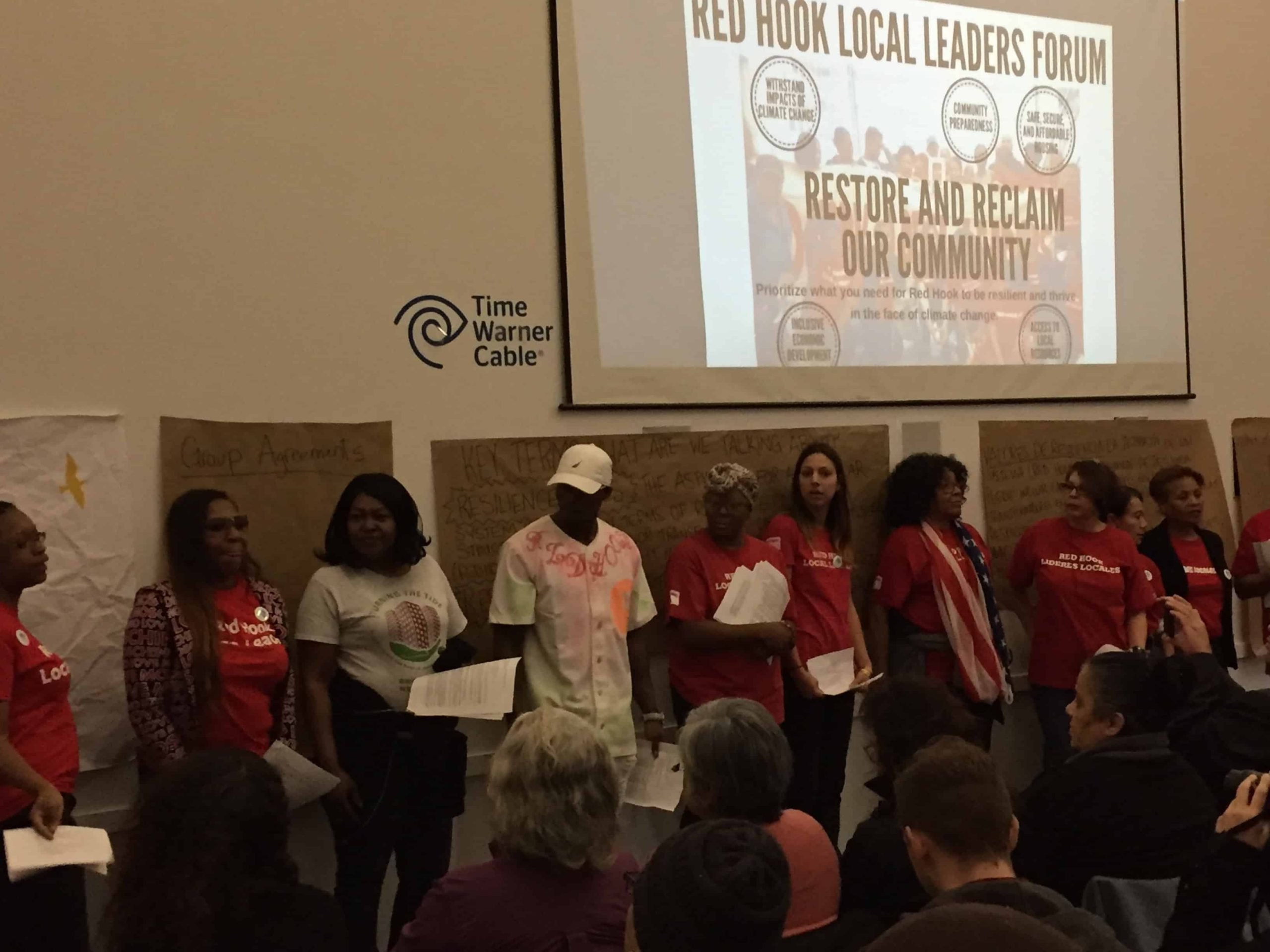
The Red Hook Local Leaders hosted a forum in a packed Red Hook Initiative on February 10 so that the community could hear from leaders and brainstorm ways to improve the neighborhood.
More than 100 Red Hook residents attended this forum, sponsored by The Rockefeller Foundation, Turning the Tide, the Mayor’s Office of Recovery and Resiliency and 100 Resilient Cities.
The Local Leaders program was developed in 2014 through lessons learned in response to Hurricane Sandy. This is a training program that is designed for public housing residents to be better prepared and learn more about emergency preparedness and community organizing.
Since 2014, RHI has trained more than 200 Red Hook public housing residents to be Local Leaders. During this program, skills are taught that help people prepare for and respond to emergencies, provide activities to deepen relationships among neighbors. There are also opportunities for leadership development, community building and intergenerational learning.
The goals, as stated in their agenda, were to increase community knowledge of climate change threats and increase community knowledge of current, past and potential resiliency projects in Red Hook.
There was also time at the end to identify community resilience priorities. The whole group gave their definitions of resiliency and then broke up and came up with more concrete ideas to make Red Hook more resilient and different programs or projects that they desire. Participants received a stipend and a T-Shirt.
This program went from 1:30 until 6:00 pm and lunch was served for everyone until about 2:00 pm. There was also a raffle drawing at the end of the program. From 2:00 until 2:30 pm there were guest remarks from people such as Catherine McBride, who is the Director of Community Building Programs at Red Hook Initiative, Jessica Colon, who is a senior advisor in the Mayor’s Office of Recovery and Resiliency and a representative from the Office of Emergency Management.
She previously worked for the Red Hook Community Justice Center.
“We have been doing a lot of work in this community for a couple of years now,” Colon said. “We are happy to have 100 Resilient Cities partnering with us to implement this event. They are partnering on the ground, with RHI as well as with support from the Rockefeller Foundation.”
For about the next half hour, Danielle Manley, who works at the center for climate systems research at the Earth Institute at Columbia University, gave a presentation on climate change overall and also how it pertains to New York City and more locally, Red Hook.
At 3:00 pm, Karen Blondel and a representative from 100 Resilient Cities, talked about their organizations. Blondel, who represents Turning the Tide, talked about climate justice and how to successfully be prepared for another disaster like Hurricane Sandy.
A major part of the afternoon was when the community was broken up into small groups to discuss and brainstorm resilient values and then come up with the activities, programs and projects they want implemented in Red Hook.
Before everyone was divided into small groups, Councilman Carlos Menchaca first addressed the group of English speakers and then went to a different room to speak to the Spanish speakers who were also divided into groups to identify their priorities.
Carolina Salguero from PortSide, Florence Neal, from Kentler International Drawing Space, Julian Morales, a communty organizer who was born and raised in the Red Hook Houses, and others, offered ideas for improving Red Hook.
Carolina wants the Red Hook community to embrace the programming at Port Side and for more NYCHA residents to come to her facility.
Menchaca talked about a recent 8-hour public housing hearing on heat issues relating to NYCHA that many in the community were at.
He also told everyone how important it is to have the community’s ideas represented.
“When we are talking about resiliency, when we are talking about the future of this incredible community, your ideas on the ground are what is going to shape the future,” Menchaca said. “This is where we put energy on the city council and city agencies to make sure we have the right teams to bring your ideas to fruition.”
Menchaca thanked the Red Hook Local Leaders – Yolanda Diaz, Tevina Willis, Leticia Cancel, Juana Narvaez, Shaquana Cooke and Bonita Felix – for making the event possible.
“This is the crew that put this together,” Menchaca said. “These are volunteers that often don’t get thanked.”
He informed the English speakers of a recent meeting at the Miccio Center that spoke of the NYCHA construction at the Houses, that will improve roofs, create resilient pathways to keep water away and bring in new heating systems. This construction is being paid for with FEMA money that followed Sandy.
Menchaca encouraged everyone to continue coming to the NYCHA construction meetings as well as ones on other topics. He thinks the meetings are important based on the amount of federal money that will be bringing in more resiliency.
“Your expertise will be helpful,” Menchaca said. “We want everyone in Red Hook to know everything that is happening.”
Salguero, who is the Founder of PortSide, is an advocate of getting kids from Red Hook to utilize Port Side as she has had international students and 4th graders from the Bronx come to the facility.
PortSide is the tanker Mary A. Whalen, on Pier 11, at the Atlantic Basin next to the Brooklyn Cruise Terminal. Their mission is to bring water stories to life. They produce water stories programs in arts, education, preservation, resiliency, workforce and harbor advocacy on and off of their historic Mary A. Whalen.
“PortSide is here right now and currently offering programs,” Salguero said. “We finally have a way to expand in the building space. I have been trying to get the Red Hook community to embrace that. I asked the Red Hook Committee multiple times.”
Morales, who used to work in Menchaca’s office, knows about the separation between NYCHA and everyone else.
“There has been a divide within the developments but there has also been a divide with NYCHA and everyone else,” Morales said. “I think that is something real to talk about.”









